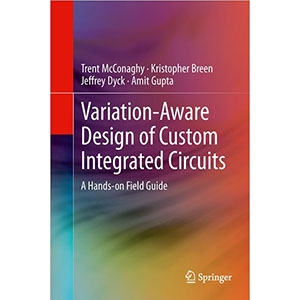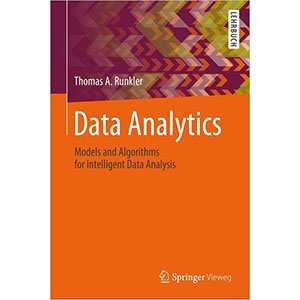Wow! eBook: Variation-Aware Design of Custom Integrated Circuits - 7 new eBooks |  |
- Variation-Aware Design of Custom Integrated Circuits
- Introduction to Biosensors
- Agile Management
- Protocol Engineering
- Information Technology in Pharmacy
- Design Thinking Business Analysis
- Data Analytics
| Variation-Aware Design of Custom Integrated Circuits Posted: 16 Jan 2013 10:38 AM PST
Book DescriptionThis book targets custom IC designers who are encountering variation issues in their designs, especially for modern process nodes at 45nm and below, such as statistical process variations, environmental variations, and layout effects. The authors have created a field guide to show how to handle variation proactively, and to understand the benefits of doing so. Readers facing variation challenges in their memory, standard cell, analog/RF, and custom digital designs will find easy-to-read, pragmatic solutions.
Table of Contents Book Details
Related Posts
The post Variation-Aware Design of Custom Integrated Circuits appeared first on Wow! eBook - Blog. |
| Posted: 16 Jan 2013 10:37 AM PST
Book DescriptionIntroduction to Biosensors: From Electric Circuits to Immunosensors discusses underlying circuitry of sensors for biomedical and biological engineers as well as biomedical sensing modalities for electrical engineers while providing an applications-based approach to the study of biosensors with over 13 extensive, hands-on labs. The material is presented using a building-block approach, beginning with the fundamentals of sensor design and temperature sensors and ending with more complicated biosensors. This book also: Provides electrical engineers with the specific knowledge they need to understand biological sensing modalities Provides biomedical engineers with a solid background in circuits and systems Includes complete coverage of temperature sensors, electrochemical sensors, DNA and immunosensors, piezoelectric sensors and immunosensing in a micofluidic device Introduction to Biosensors: From Electric Circuits to Immunosensors aims to provide an interdisciplinary approach to biosensors that will be appreciated by biomedical, biological, and electrical engineers.
Table of Contents Book Details
Related Posts
The post Introduction to Biosensors appeared first on Wow! eBook - Blog. |
| Posted: 16 Jan 2013 10:33 AM PST
Book DescriptionIf you have tried to implement Agile in your organization, you have probably learned a lot about development practices, teamwork, processes and tools, but too little about how to manage such an organization. Yet managerial support is often the biggest impediment to successfully adopting Agile, and limiting your Agile efforts to those of the development teams while doing the same old-style management will dramatically limit the ability of your organization to reach the next Agile level. Ángel Medinilla will provide you with a comprehensive understanding of what Agile means to an organization and the manager's role in such an environment, i.e., how to manage, lead and motivate self-organizing teams and how to create an Agile corporate culture. Based on his background as a "veteran" Agile consultant for companies of all sizes, he delivers insights and experiences, points out possible pitfalls, presents practical approaches and possible scenarios, also including detailed suggestions for further reading. If you are a manager, team leader, evangelist, change agent (or whatever nice title) and if you want to push Agile further in your organization, then this is your book. You will read how to change the paradigm of what management is about: it is not about arbitrary decisions, constant supervision and progress control, and the negotiation of changing requirements. It is about motivation, self-organization, responsibility, and the exploitation of all project stakeholders' knowledge. We live in a different world than the one that most management experts of the 20th century describe, and companies that strive for success and excellence will need a new kind of manager – Agile managers.
Table of Contents Part II: Agile Management Book Details
Related Posts
The post Agile Management appeared first on Wow! eBook - Blog. |
| Posted: 16 Jan 2013 09:04 AM PST
Book DescriptionCommunication protocols form the operational basis of computer networks and telecommunication systems. They are behavior conventions that describe how communication systems interact with each other, defining the temporal order of the interactions and the formats of the data units exchanged – essentially they determine the efficiency and reliability of computer networks. Protocol Engineering is an important discipline covering the design, validation, and implementation of communication protocols. Part I of this book is devoted to the fundamentals of communication protocols, describing their working principles and implicitly also those of computer networks. The author introduces the concepts of service, protocol, layer, and layered architecture, and introduces the main elements required in the description of protocols using a model language. He then presents the most important protocol functions. Part II deals with the description of communication protocols, offering an overview of the various formal methods, the essence of Protocol Engineering. The author introduces the fundamental description methods, such as finite state machines, Petri nets, process calculi, and temporal logics, that are in part used as semantic models for formal description techniques. He then introduces one representative technique for each of the main description approaches, among others SDL and LOTOS, and surveys the use of UML for describing protocols. Part III covers the protocol life cycle and the most important development stages, presenting the reader with approaches for systematic protocol design, with various verification methods, with the main implementation techniques, and with strategies for their testing, in particular with conformance and interoperability tests, and the test description language TTCN. The author uses the simple data transfer example protocol XDT (eXample Data Transfer) throughout the book as a reference protocol to exemplify the various description techniques and to demonstrate important validation and implementation approaches. The book is an introduction to communication protocols and their development for undergraduate and graduate students of computer science and communication technology, and it is also a suitable reference for engineers and programmers. Most chapters contain exercises, and the author’s accompanying website provides further online material including a complete formal description of the XDT protocol and an animated simulation visualizing its behavior.
Table of Contents Part II: Description of Communication Protocols Part III: Development of Communication Protocols Book Details
Related Posts
The post Protocol Engineering appeared first on Wow! eBook - Blog. |
| Information Technology in Pharmacy Posted: 16 Jan 2013 09:03 AM PST
Book DescriptionOver the last 30-40 years, information technology (IT) has revolutionized professional life for millions of people around the world. IT has reduced the need for bulk storage of paper records by organizations, has enabled automation of tasks that were previously repetitive and labor-intensive, and carry them out in a fast and accurate way, has enabled economies of scale, improved efficiencies and enabled new ways of working that were hitherto impossible. In parallel with the rise of IT during the last 40 years, the role of the pharmacist – and the society in which pharmacists work – has changed considerably. Pharmacists are no longer principally compounders of medicines, but they are still responsible for ensuring that the patient receives the correct medicine, ensuring that the patient understands why they should take their medicine, and helping the patient with taking the medicine and being concordant with therapy. Information Technology in Pharmacy: an Integrated Approach provides a concise and practical general introduction to pharmacy IT, discusses issues surrounding the adoption of technology and how technologies may be utlilized by the pharmacy profession to exercise new professional roles and achieve new professional aspirations. This book will be of prime interest to practicing pharmacists at all levels, pharmacy students and pharmacy educators, but also to health informaticians, hospital and health care system administrators.
Table of Contents Book Details
Related Posts
The post Information Technology in Pharmacy appeared first on Wow! eBook - Blog. |
| Design Thinking Business Analysis Posted: 16 Jan 2013 09:02 AM PST
Book DescriptionThis book undertakes to marry the concepts of Concept Mapping with a Design Thinking approach in the context of business analysis. While in the past a lot of attention has been paid to the business process side, this book now focusses information quality and valuation, master data and hierarchy management, business rules automation and business semantics as examples for business innovation opportunities. The book shows how to take Business Concept Maps further as information models for new IT paradigms. In a way this books redefines and extends business analysis towards solutions that can be described as business synthesis or business development. Business modellers, analysts and controllers, as well as enterprise information architects, will benefit from the intuitive modelling and designing approach presented in this book. The pragmatic and agile methods presented can be directly applied to improve the way organizations manage their business concepts and their relationships.
“This book is a great contribution to the information management community. It combines a theoretical foundation with practical methods for dealing with important problems. This is rare and very useful. Conceptual models that communicate business reality effectively require some degree of creative imagination. As such, they combine the results of business analysis with communication design, as is extensively covered in this book.” "Truly understanding business requirements has always been a major stumbling block in business intelligence (BI) projects. In this book, Thomas Frisendal introduces a powerful technique—business concept mapping—that creates a virtual mind-meld between business users and business analysts. Frisendal does a wonderful explaining and demonstrating how this tool can improve the outcome of BI and other development projects .” “This book addresses the timely topic of how businesses can become more effective by allowing its stakeholders to analyse their business domain better than before. The good news for the reader is that the naturality of the models used in the book today have direct applicability in software systems, which means the changes in business can be faster reflected in IT.” Table of Contents Part I: Design Thinking Business Analysis Part II: Business Concept Mapping Part III: Business Innovation Using Mapped Business Concepts Book Details
Related Posts
The post Design Thinking Business Analysis appeared first on Wow! eBook - Blog. |
| Posted: 16 Jan 2013 09:02 AM PST
Book DescriptionThis book is a comprehensive introduction to the methods and algorithms and approaches of modern data analytics. It provides a sound mathematical basis, discusses advantages and drawbacks of different approaches, and enables the reader to design and implement data analytics solutions for real-world applications. This book has been used for more than ten years in numerous courses at the Technical University of Munich, in short courses at several other universities, and in tutorials at scientific conferences. Much of the content is based on the results of industrial research and development projects at Siemens. Content Target Groups
The Author Table of Contents Book Details
Related Posts
The post Data Analytics appeared first on Wow! eBook - Blog. |
| You are subscribed to email updates from Wow! eBook - Blog To stop receiving these emails, you may unsubscribe now. | Email delivery powered by Google |
| Google Inc., 20 West Kinzie, Chicago IL USA 60610 | |








Tidak ada komentar:
Posting Komentar